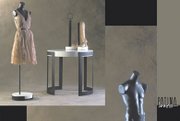Recession Changed the Game for Visual Display
With the economy showing signs of recovering, phones are ringing again at offices of visual-display companies. But their way of doing business has changed, said Brad Somberg, president of Burlingame, Calif.–based design company B&N Industries and a 30-year veteran of the visual-display game.
“I think money is being infused back into the marketplace, but it is more intelligent” said Somberg, who also serves on the board of directors for trade group Association of Retail Environments. “For every dollar spent, [retailers] are expecting more value for their dollar,” he said.
In the months preceding the Great Recession, retailers began trying to stretch their visual-display budgets by looking for the most cost-effective ways of making a store sparkle. In the past 18 months, it sometimes meant relying more on signage and graphics than a whole package of displays, once an industry norm, some industry veterans said.
The result has been a bracing learning curve for the visual-display industry and finding some new, creative ways to dress up a store. As retailers’ demands change, visual-display executives have been learning how to create a high-quality product at budget prices.
Visual-display workers were some of the first casualties of the Great Recession. Many brands and stores also cut their visual-display departments and started relying more on free-lancers, according to Zach Augustine, chief creative officer for merchandising consulting company Winston Retail, which is headquartered in San Francisco. At B&N, some clients asked the visual-display company to reduce the costs of some projects by 40 percent, Somberg said. For Patina V, the City of Industry, Calif.–based designer of mannequins and other visual-display products, orders from large clients, such as Nordstrom and Kohl’s, slimmed down as retailers cut down on inventory.
For Norm Glazer, Patina V’s president and chief executive, the solution to remaining profitable was found in developing new product and prospecting new sales.
“We knew Nordstrom and Kohl’s,” Glazer said. “But there were a lot of ma-and-pa stores and specialty chains out there we didn’t know. Patina V’s salespeople had to go to places they didn’t know.”
Just because economic times were tough did not mean that retailers were satisfied with last season’s visual-display products, Glazer said. Retailers always want bold fixtures and beautiful mannequins to call attention to their merchandise. However, during the recession, some retailers needed to cut corners.
If they could not afford mannequins constructed out of Patina V’s Duraflex material, which Glazer said is shock-proof so it won’t crack when dropped, Patina V also offers products manufactured out of fiberglass. The fiberglass product might cost 15 percent less than Duraflex products; however, fiberglass is not as sturdy as high-grade Duraflex.
Other retailers met the challenges of the recession by creating displays out of everyday and some found materials. “It’s one way to be cost-conscious,” said Nicole Rehfuss, senior retail visual strategist at architectural firm Little. In 2009, the Anthropologie store in Short Hills, N.J., created a chandelier display out of plastic bottles and flowers. The novel use of things typically destined for a recycling bin was reportedly received enthusiastically by consumers, and the look was rolled out to the entire chain in 2010, according to a company statement.
Another way to be cost-conscious was for retailers to communicate more with simple visual-display items, Somberg said.
“We aggressively came out with understandable, useful products that could have an impact—nesting tables, graphic systems, display pedestals, anything that could be understood quickly and create excitement for a diversity of products,” Somberg said.
If visual-display companies found themselves serving a leaner market, the surviving members of visual display found something else about themselves. “We became better business people,” Somberg said. “We got creative with a diverse line of products that can cross a lot of different retail needs.”






















